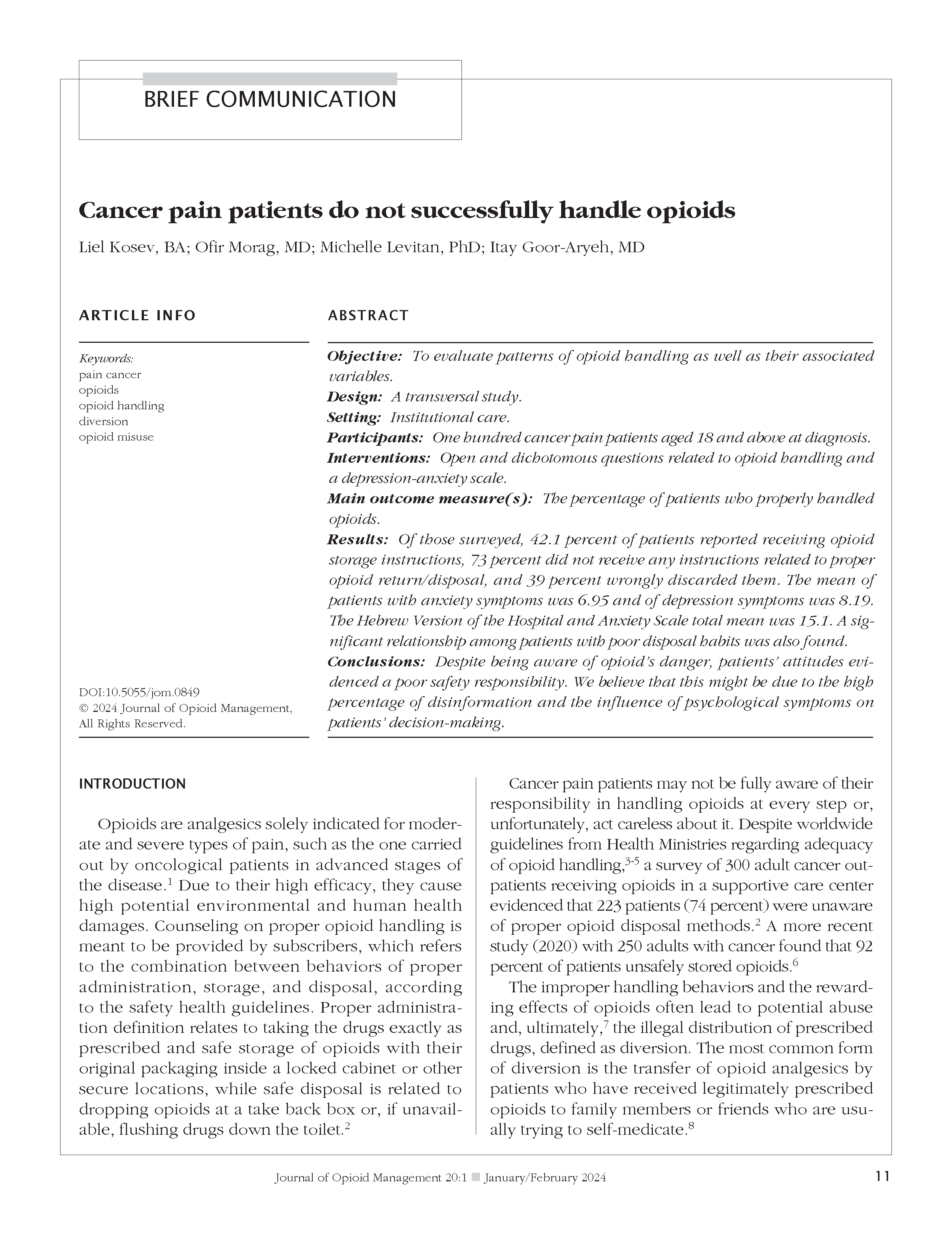Cancer pain patients do not successfully handle opioids
DOI:
https://doi.org/10.5055/jom.0849Keywords:
pain cancer, opioids, opioid handling, diversion, opioid misuseAbstract
Objective: To evaluate patterns of opioid handling as well as their associated variables.
Design: A transversal study.
Setting: Institutional care.
Participants: One hundred cancer pain patients aged 18 and above at diagnosis.
Interventions: Open and dichotomous questions related to opioid handling and a depression-anxiety scale.
Main outcome measure(s): The percentage of patients who properly handled opioids.
Results: Of those surveyed, 42.1 percent of patients reported receiving opioid storage instructions, 73 percent did not receive any instructions related to proper opioid return/disposal, and 39 percent wrongly discarded them. The mean of patients with anxiety symptoms was 6.95 and of depression symptoms was 8.19. The Hebrew Version of the Hospital and Anxiety Scale total mean was 15.1. A significant relationship among patients with poor disposal habits was also found.
Conclusions: Despite being aware of opioid's danger, patients' attitudes evidenced a poor safety responsibility. We believe that this might be due to the high percentage of disinformation and the influence of psychological symptoms on patients' decision-making.
References
Manchikanti L, Fellows B, Ailinani H, et al.: Therapeutic use, abuse, and nonmedical use of opioids: A ten-year perspective. Pain Physician. 2010; 13(5): 401-435. DOI: https://doi.org/10.36076/ppj.2010/13/401
Reddy A, de la Cruz M, Rodriguez EM, et al.: Patterns of storage, use, and disposal of opioids among cancer outpatients. Oncologist. 2014; 19(7): 780-785. DOI: https://doi.org/10.1634/theoncologist.2014-0071
FDA: Disposal of unused medicines: What you should know. Available at http://www.fda.gov/Drugs/ResourcesForYou/Consumers/BuyingUsingMedicineSafely/EnsuringSafeUseofMedicine/SafeDisposalofMedicines/ucm186187.htm. Accessed February 15, 2023.
Office of Diversion Control: Drug disposal information. Available at http://www.deadiversion.usdoj.gov/drug_disposal/index.html. Accessed February 15, 2023.
Caraceni A, Hanks G, Kaasa S, et al.: European Palliative Care Research Collaborative (EPCRC); European Association for Palliative Care (EAPC). Use of opioid analgesics in the treatment of cancer pain: Evidence-based recommendations from the EAPC. Lancet Oncol. 2012; 13(2): e58-68-e68.
Madden K, Reddy A, De La Cruz M, et al.: Patterns of storage, use, and disposal of prescription opioids by young adults with cancer. J Adolesc Young Adult Oncol. 2021; 10(2): 234-239. DOI: https://doi.org/10.1089/jayao.2020.0083
Gregorian R, Marrett E, Sivathanu V, et al.: Safe opioid storage and disposal: A survey of patient beliefs and practices. J Pain Res. 2020; 13(13): 987-995. DOI: https://doi.org/10.2147/JPR.S242825
Silvestre J, Reddy A, de la Cruz M, et al.: Frequency of unsafe storage, use, and disposal practices of opioids among cancer patients presenting to the emergency department. Pall Supp Care. 2017; 15(6): 638-643. DOI: https://doi.org/10.1017/S1478951516000158
Mitchell AJ, Chan M, Bhatti H, et al.: Prevalence of depression, anxiety, and adjustment disorder in oncological, haematological, and palliative-care settings: A meta-analysis of 94 interview-based studies. Lancet Oncol. 2011; 12: 160-174. DOI: https://doi.org/10.1016/S1470-2045(11)70002-X
Arora A, Saini SK, Nautiyal V, et al.: Cancer pain, anxiety, and depression in admitted patients at a tertiary care hospital: A prospective observational study. Indian J Palliat Care. 2019; 25(4): 562-566. DOI: https://doi.org/10.4103/IJPC.IJPC_4_19
Zigmond AS, Snaith RP: The hospital anxiety and depression scale. Acta Psychiatr Scand. 1983; 67(6): 361-370. DOI: https://doi.org/10.1111/j.1600-0447.1983.tb09716.x

Published
How to Cite
Issue
Section
License
Copyright 2005-2025, Weston Medical Publishing, LLC and Journal of Opioid Management. All Rights Reserved.










